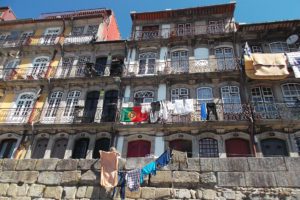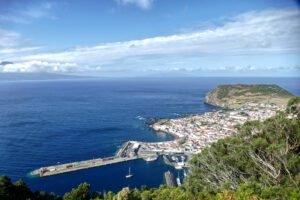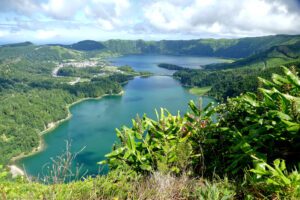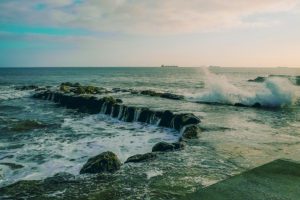…and of all of Portugal, for that matter. The island of Pico is not only one of the top destinations when it comes to the Azores. With Mount Pico, it also has the country’s highest peak.
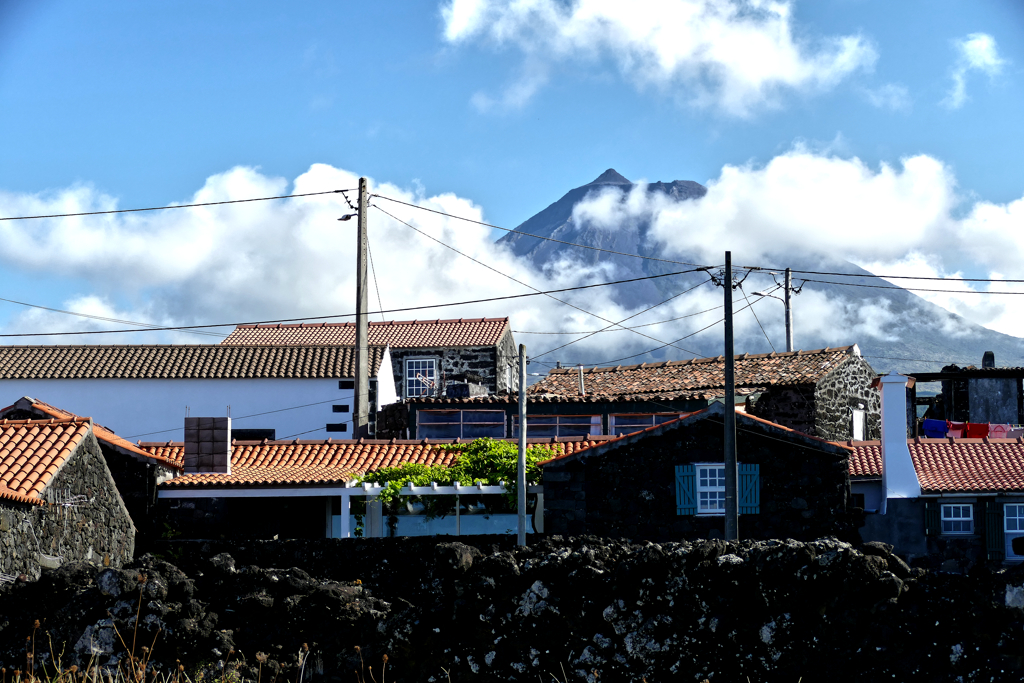
Pico
Who would have thought that cows would one day become an important part of my most attractive photos? But yes, cows in all possible shades from brown, spotted, light beige to deep black are actually the pretty spots in the lush green grass of the pastures between which we wind our way up the country road towards Pico.

Towards Pico, the mountain. Since yesterday, I have been on Pico, the island that is home to this highest point in Portugal.

A Late Bloomer
Although the Azores had been inhabited since 1439, the settlement of Pico only began at the end of the 15th century. Pico is believed to be the last of the Central Group islands to be occupied. The population grew slowly, mainly due to the difficulties in growing agricultural goods. The soils are mostly volcanic and consist of weathered, recent basalt. In addition, the island has few rivers compared to other parts of the archipelago. All of this made it difficult to extract income from the land, and by the end of the 16th century, fewer than 3,000 people were living on Pico.

The last magma eruption was in 1720 and created the volcanic cinder cone called Silveira.
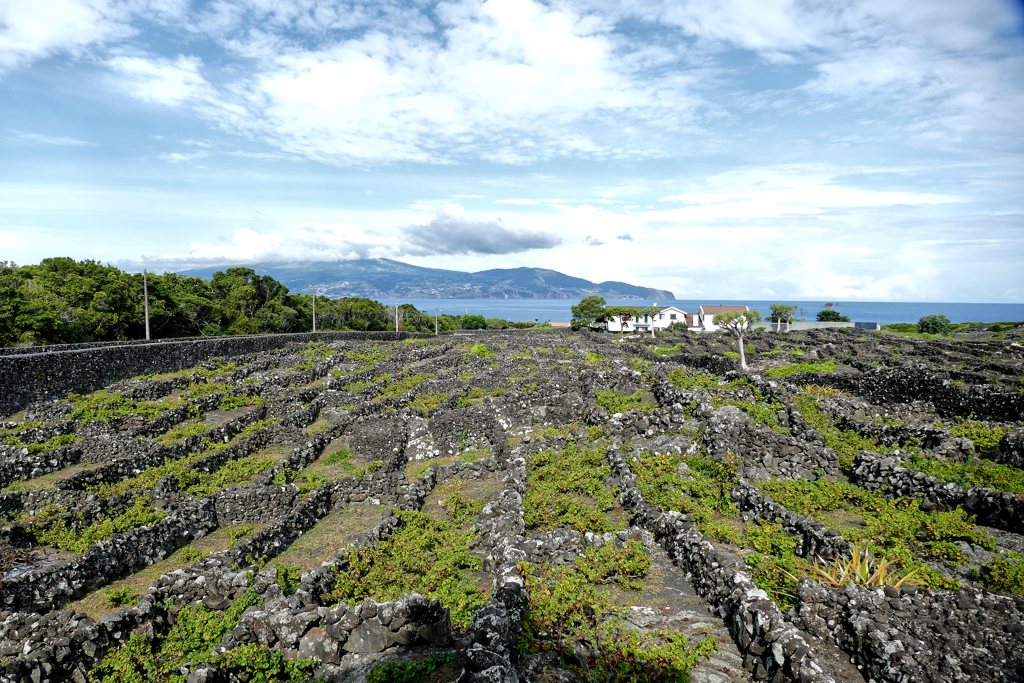
Around 200 years ago, the famous Verdelho wine began to be produced on Pico. It was quickly exported to many countries and even delivered to the palace of the Russian Tsar. Sadly, viticulture declined with the spread of mildew and phylloxera in the mid-19th century. This led to an economic crisis that lasted into the 20th century. In 2004, UNESCO recognized the fact that the family businesses still stuck to tradition and produced great wines against all odds by placing them on the list of World Heritage Sites.
The Times They Are A-Changin’
Another, in my opinion, less praiseworthy economic activity was whaling. American and British whalers introduced it into the waters of the Azores at the end of the 18th century. Sperm whale hunting became the island’s main industry until it was abolished when, in 1982, Portugal officially stopped whaling. However, the last whale was killed by a whaler from Pico Island in 1987.

Today, the former whale factory is a museum. Strictly speaking, whales still provide income today, but fortunately, it’s now in the form of bloodless whale watching.
Pico is located almost 18 kilometers south of São Jorge and just eight kilometers east of Faial in the so-called central group of the Azores. The area is also colloquially called O Triângulo, hence, the triangle. It is the second largest of the Azores islands.
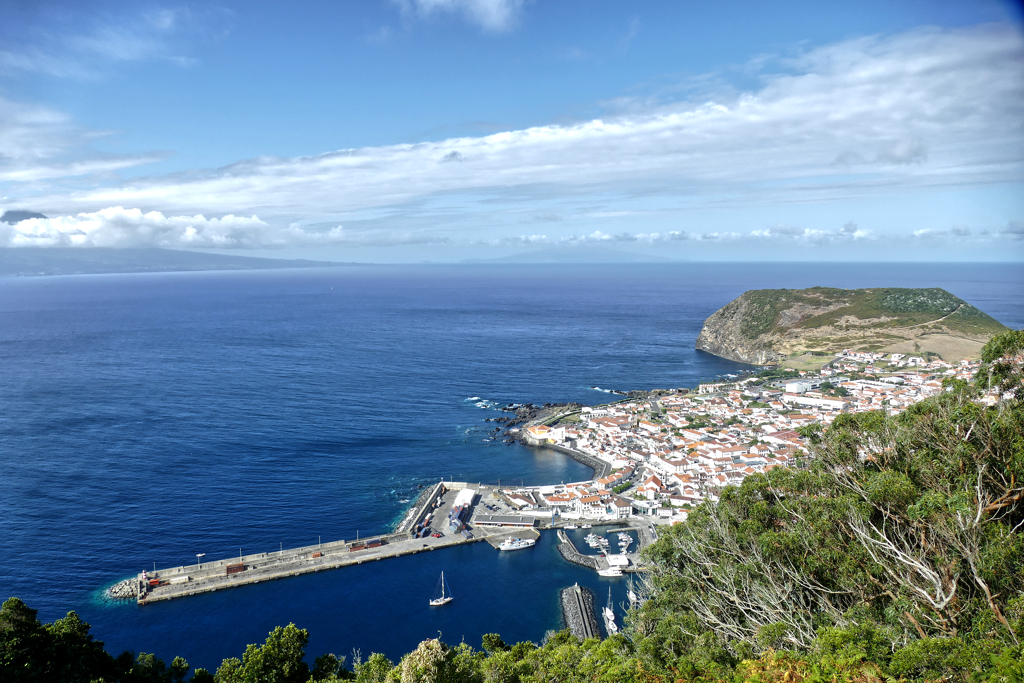
Like the rest of the islands in the archipelago, Pico enjoys a mild maritime climate almost all year round, with constant winds and high rainfall in winter. Due to the topography, temperature and precipitation vary significantly depending on altitude and location, forming rapidly changing microclimates.
Unlike its little sister Faial, Pico does not have any sandy beaches, but there are some beautiful and very safe swimming spots at the natural swimming pools formed from lava.
Pico Means Peak
We were on our way up the mountain, and we were in a car. None of our group of five planned to climb Pico. Not during the day, and not at night either.
Nevertheless, this is by far one of the most popular activities among visitors to the island. “Oh, I’ve only been up there once,” Jose says somewhat disparagingly. He’s in his early twenties, speaks perfect English, and today, he’s our guide.
Well, I probably won’t even have a one-time climb to show for it, but that’s okay because, like so many things in life, the journey is the goal, and the drive up the foothills of the mountain is absolutely fantastic. Whether it is the green meadows and fields right around us or the breathtaking views of the towns on the coast of the island. And over there behind the Atlantic, we can even see Faial, the elegant neighboring island, on the horizon.
I am very satisfied with my life and my physical possibilities.
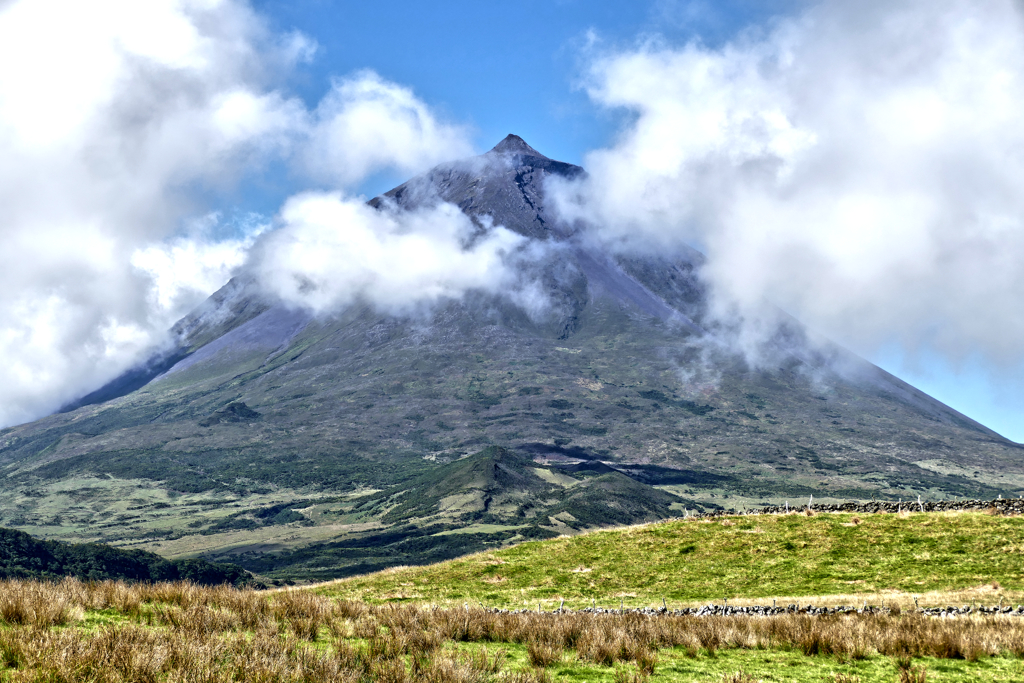
Pico, full name Ponta do Pico, is a stratovolcano with an impressive height of 2351 meters. At its top is a volcanic crater 500 meters in diameter and 30 meters deep. The actual summit, however, is the so-called Piquinho, a small volcanic cone 70 meters high.
Casa da Montanha
However, although our lot was in no way equipped to climb the mountain, that doesn’t mean we didn’t want to enjoy the great views. Therefore, our stop was the Casa da Montanha.

As a matter of fact, the Mountain’s House is a mandatory stop for everyone. Its main purpose is to instruct and support those who actually want to climb the mountain, obviously. For safety reasons, this is where you have to register. Also, they check if everything is in accordance with the regulations. The climb is about 3.8 kilometers long and has a difference in altitude of 1150 meters, being, therefore, very steep. In fact, you are allowed to climb Pico without a guide, however, only 320 climbers are allowed per day. The trail is clearly marked, in addition, you are required to sign up for GPS tags so the rangers can track you at all times while climbing. For understandable reasons, those responsible want to know who is scrambling around on the mountain.
However, here are some options if you want to join a guided group:
Madalena
Our island tour with Jose had started in Pico’s capital Madalena. The town is located on the west coast and is connected to Horta on the neighboring island of Faial via an eight-kilometer sea route.

Directly behind the harbor in the city center rises the three-aisled parish church Igreja Santa Maria Madalena from the 17th century. Madalena is pleasant, but honestly doesn’t have a whole lot of excitement to offer.
What Not to Miss
An absolute must-visit is definitely the Museu do Vinho, Madalena’s wine museum. It is
Housed in a former Carmelite monastery built in the 17th century. In the huge outdoor area, the traditional method of growing wine is shown between walls made of lava rock, which is typical of the Azores. After all, UNESCO named the locally practiced wine-growing culture a World Heritage site in 2004.

Another highlight of the museum is the extraordinarily large dragon trees, the oldest of which is said to be 1,000 years old. These trees were of great economic importance to the island until the 1960s. When their bark is scratched, a red sap comes out, which has been used for centuries to dye textiles and make a painkiller. The tree gets its name because the color is reminiscent of the blood of dragons.

Things get particularly nice in Madalena in the early evening when visitors come back from hiking, mountaineering, and election watching and meet up for a drink in the local pubs or take a quick dip in the lava pools.
From April to September, the Museum is open from Tuesday to Sunday between 10 a.m. and 5.30 p.m. From October to March, they are already closing at 5 p.m.
Vinha de Criação Velha
Wine growing has a long tradition in Pico and has been a huge deal even before UNESCO awarded it its listing. For centuries, the wine has been exported to many European countries and the Americas. Legend has it that in days gone by, Pico’s wine was even enjoyed during banquets of the Russian Tsars.
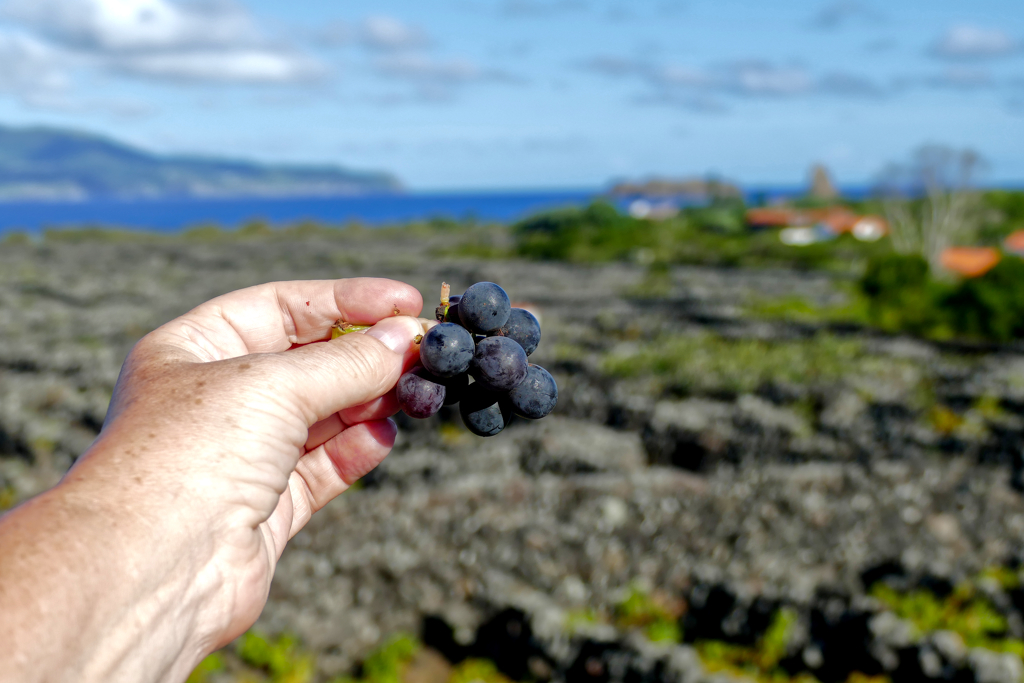
Yet at first glance, it seems strange that the island’s harsh conditions produce such a high-quality drink. However, the cultivation began in the late 15th century, when the island was first settled.
Pico is a comparatively young island in the Azores, as it was formed around 270,000 years ago. Due to this fact, as well as due to relatively recent eruptions and lava flows, the basaltic bedrock did not have time to degrade and create soil. In the volcanic lake soil are 60 to 120-year-old vineyards.

Thanks to the volcanic soil, which is rich in nutrients, the relatively dry and warm climate, and the protective stone walls that are heated by the sun, the vines have excellent ripening conditions. In addition, numerous species of flora and fauna are part of this natural habitat.
Criação Velha is the most authentic example of the art of using the land by creating the traditional Currais, painstakingly erected stone walls.
While I visited the amazing Paisagem da Vinha de Criação Velha on a guided day tour, you can easily get there from Madalena by walking in less than an hour.
Lajes
Roughly summarized, Pico’s trinity of attractions is, of course, the mountain, but also wine growing and whaling. Fortunately, the latter has only existed as an anachronism for some time. But it’s still the reason why our next stop was Lajes.

Lajes is a charming municipality located on the southern coast. It has a rich history as a whaling hub. Today, the Museu dos Baleeiros, hence, the Whalers’ Museum showcases the island’s whaling past, with exhibits on the tools, boats, and the lives of whalers. Like many forms of wild animal hunting, whaling is a hot topic. For hunters on the one hand and animal rights activists on the other, the matter is clear.

I’m actually on the side of animal rights activists, but I can see a difference when a community hunts animals to secure their own existence, or whether animal capture is industrial or just for fun. Unfortunately, I found all of these aspects missing from the film shown in the museum. It was clearly older and shows quite unrestrained scenes of whaling.

On the other hand, in its somewhat pathetic approach, it was unintentionally funny at times. By the way, that was the only reason why I stayed seated and only partially covered my eyes. All in all, I would have liked a film with a lot more information and a lot less blood.
From April to September, the Museum is open from Tuesday to Sunday between 10 a.m. and 5.30 p.m. From October to March, they are already closing at 5 p.m.
A More Hidden Gem
Instead of killing whales, Lajes is now known for watching them. The waters surrounding Pico are home to a variety of marine life, including sperm whales, blue whales, and dolphins. Several local companies offer tours that allow visitors to experience the majesty of these creatures up close.
The village of Lajes is perfect for those who want to immerse themselves in the tranquil, unspoiled beauty of the Azores. The city is surrounded by stunning scenery, from the rugged coastline with natural swimming pools to lush green fields with traditional basalt stone walls. There is also a regular bus service between Madalena and Lajes, so you can have peace and quiet but not be completely cut off from the world.
Sidenote: You Get What You Pay For
Now I have to say something about tourism as such in the Azores. Already in São Miguel, which is supposedly the most touristy of all the islands, I noticed that tourism felt different. Industrialization is missing. No, not every visitor is personally greeted with a small parade. But due to the lower number of visitors, all services feel much more personal than on the Canary Islands, for example. The locals are not annoyed by the streams of visitors, and on tours, you are not simply escorted through and processed. Everything feels more individual and personal. I really liked that. However, I have to add that organized tours, for example, are also a little more expensive. But I’m happy to pay a few euros more for an unforgettable, pleasant experience.

One of the big differences from other parts of the world where I have taken organized tours is the quality of the food included. On every tour, the lunch was excellent, freshly prepared, and attractively presented. And drinks were even included! This was also the case with our lunch, which we had at O Lavrador, located just minutes north of Lajes. Even if you do the tour on your own, I wholeheartedly recommend that you stop off there.
They are open every day from noon until 7 p.m. and serve their excellent food on an all-you-can-eat buffet.
Wine Tasting
After we had seen in the morning how much effort wine production still takes today, after lunch, it was time to convince ourselves of the quality of the products. And there is hardly a better place for that than the Adega A Buraca.
The Adega A Buraca is a family-run winery with a small museum. In addition to wine growing, the focus here is on other areas of agriculture and traditional crafts of the Azores.
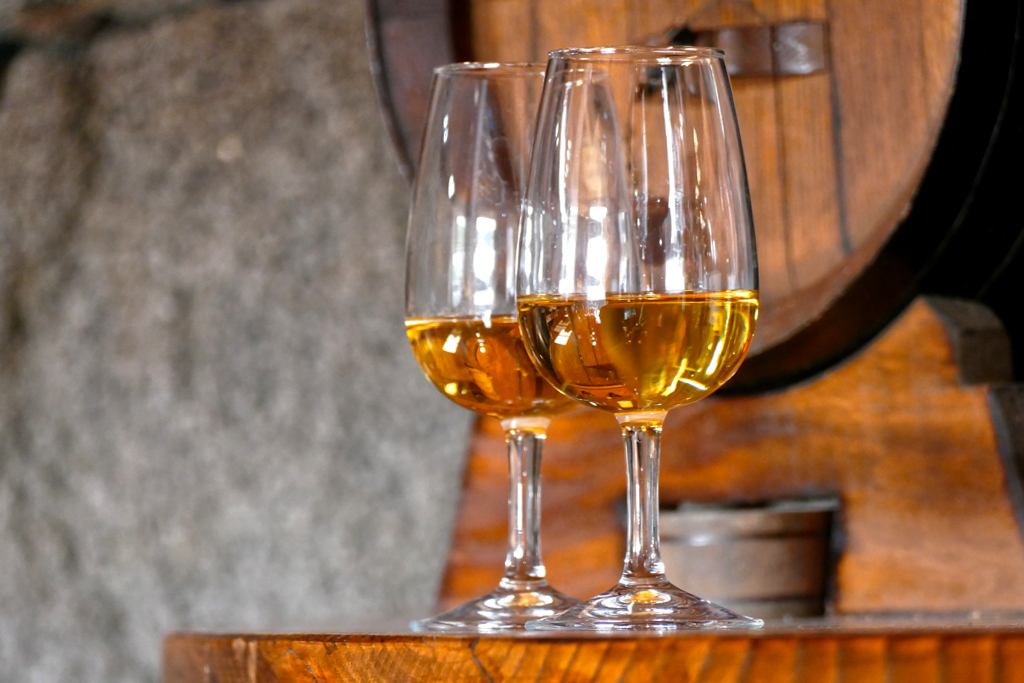
Manager Christina showered us with information, wine, and spirits at the tasting. Her love of history, culture, and the winemaking process was an absolute inspiration.
Appropriate Decoration
I was a little distracted by the decoration of the room, though: We were sitting on wine barrel-shaped stools at a table shaped like a halved wine barrel. The cupboards were wine barrels with doors – the whole world seemed to have become a wine barrel.
It was a lot of fun, but it didn’t inspire me to redecorate my apartment, if you know what I mean…

In the front part of the house is a small shop where, in addition to wine, you can also buy art and jewelry from the region.

In the Adega A Buraca, the difference from other guided tours became clear to me once again: Christina’s presentation never felt like a sales pitch. She presented us with pride and conviction about what she and her family have been making for generations.
At no point did I feel the expectation of having to buy anything in return or even feel compelled to purchase.
I’ve experienced this very differently in the past during similar visits and tastings.
The Adega A Buraca is open on weekdays from 9 a.m. to 5.30 p.m.
They supposedly also serve a delicious lunch, however, I would inquire about that beforehand. Not that you have to endure the schnapps tasting on an empty stomach.
Cachorro
The last stop on our tour was Cachorro. It’s a tiny village on the north coast, very close to the airport. The village owes its name to a curious rock that is reminiscent of a dog’s head. Cachorro means puppy in Portuguese.
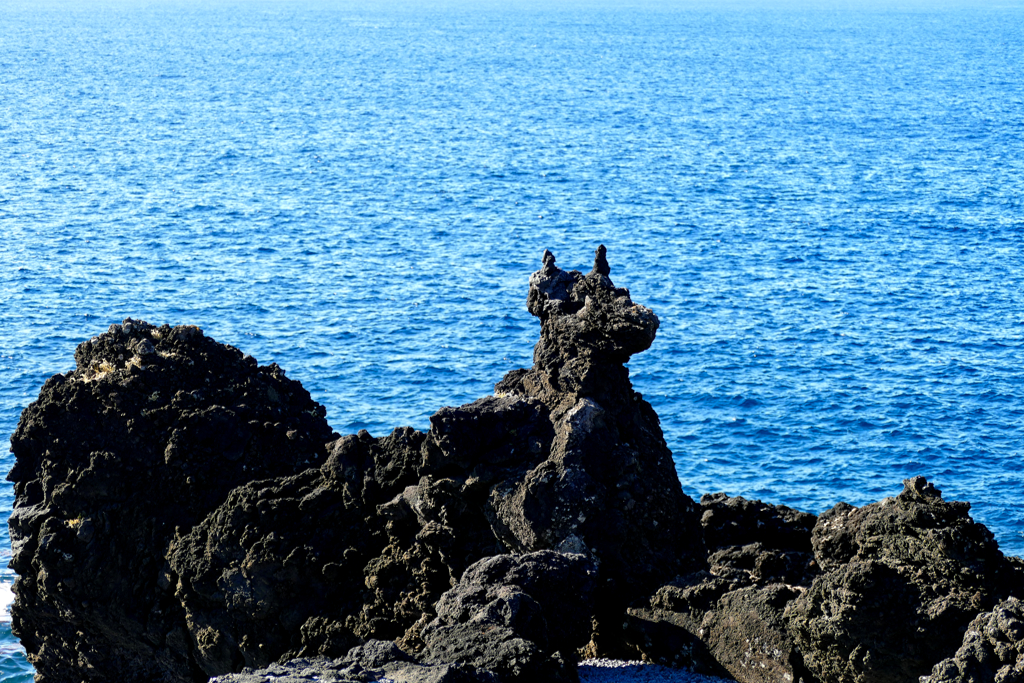
In 1718, during the eruption of Pico, the lava pushed itself up to the coast and formed bizarre shapes. Walking a little along the coast, you will find some lava bridges and grottos. However, you should definitely pay attention to the loose and sharp-edged floor, which could collapse in places.
There are fascinating caverns, caves, and gates in which the surging sea creates an impressive natural spectacle. In some places, the spray crashes out of the rock crevices with incredible force.

There is also a small harbor in Cachorro. However, the bay is only safe when the weather is stable. Concrete stairs lead down to the boat ramp.
Only a few people live permanently in Cachorro.
Many of the typical natural stone houses are only used as summer homes.

In a tasting room, you can sample the delicious aperitif wine Verdelho, pomace schnapps, as well as blackberry and honey liqueur. Don’t miss out on the fig schnapps Bagaco de Cachorro.
You don’t necessarily have to visit Cachorro as part of an organized excursion. From Madalena, you can get there by bike or on foot in half an hour or two hours.
Lava Pools
While the lava formations around Cachorro are impressive, they should be explored with great caution. There are several lava pools along Pico’s coast where it is safe to swim.
The Lava Pools are natural volcanic formations located along the island’s rugged coastline. The cooling and solidification of lava flows created unique, naturally enclosed basins. Tides and waves constantly fill them with fresh, crystal-clear water.

Unlike conventional swimming spots, the lava pools offer a one-of-a-kind experience of swimming in naturally sheltered waters while still enjoying the ocean. These pools are far less affected by ocean currents, making them relatively safe and tranquil. Therefore, they are also an excellent opportunity for snorkeling.
This being said, keep in mind that they are still natural, hence there might be surprises such as sharp edges or protruding stones. I actually managed to kick a rock with full force – my toes were a deep blue for days.
In any case, wearing swimming shoes with non-slip soles is safer.

Compared to more commercialized tourist destinations, the lava pools on Pico are often quiet and serene, offering a peaceful escape from the hustle and bustle of daily life. Nevertheless, they are equipped with facilities like sunbathing areas, showers, and snack bars.
Whether you’re an adventure seeker or in search of tranquility, Pico’s Lava Pools offer a memorable experience.
Practical Information
How to Get There
By Plane
Pico’s airport is located about eight kilometers east of Madalena. There are direct connections to Terceira and São Miguel, from where you can then continue to the other islands or connect to international flights. However, there are also some direct flights from and to Lisbon.
Cabs on the Azores are not metered, but the drivers are men of honor and don’t screw visitors over. Fares on the islands are fixed, and a ride to the center of Madalena, for instance, sets you back ten €uros.
By Ferry
Ferries offer a scenic and often inexpensive way to travel between the Azores. This mostly works very well, especially within the central archipelago, as the islands there are close to each other. Yet, if you are flexible and willing to adapt to seasonal schedules, you can basically travel to all the islands by sea.
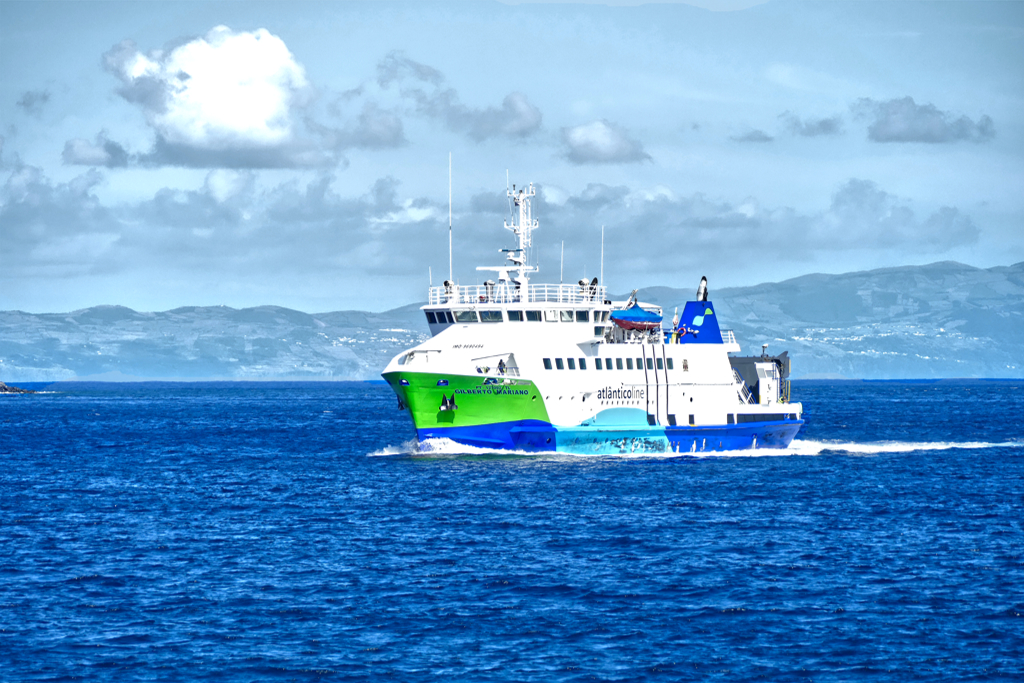
Especially from June to September, the connections are more frequent and most islands are served daily. However, it is advisable to book ferry tickets in advance, especially during these months, as ferries are often fully booked.

However, keep in mind that ferry connections are heavily dependent on the weather. Especially in autumn and winter, trips can be canceled at short notice due to strong winds or high waves.
It is advisable to find out about the current departure times shortly before the start of your trip. Atlânticoline provides current timetables and booking options on their website.
How to Get Around
There are two bus routes on Pico, but they are not ideal for tourist visits. One line runs from Madalena along the north coast via São Roque to Piedade. The second connection is from Madalena along the south coast via Lajes to Ribeirinha.
If you change the bus at the easternmost stop, you can even go on a tour of the island in one day. Buses run twice in each direction during the day on weekdays. On Sundays, there is only one connection at a time. There are no bus connections to the hinterland or directly to the coast.

You get all the information and schedules on this flyer. Also, Google Maps shows you the scheduled trips.
As on all the Azores, cab prices on Pico are fixed and relatively modest.
Hiking is very popular and a great way of exploring Pico’s hinterland. Obviously, you can also rent a bike and cycle the island. However, I wouldn’t be too euphoric about it as Pico is quite hilly in many parts.
Organized Trips
“The situation with public transport is really very bad. You can’t explore the island by exclusively using public transport!”
How many times have I heard this warning, and it has never put me off. Whether Martinique or Curaçao – through good planning, I always managed to visit the places I wanted to see by public bus. Only very rarely have I had to give up my plans.
The Azores are, unfortunately, one such case.
If you don’t rent your own vehicle and don’t want to spend hours figuring out complicated bus connections, it’s best to join an organized day trip.
Also, while in the past, I mainly joined organized day trips from time to time when there was no convenient public transport option, I now do it for safety reasons. Believe me, you do not want to sit by yourself in the wilderness with no opportunity to call for assistance as I did during a hiking accident in Gran Canaria. Therefore, take at least a hiking buddy with you, especially when exploring impassable and rough terrain.
Or, even better, go with a knowledgeable local guide.
No matter your reason for wanting to join an organized excursion, here are some great options for exploring Pico on guided tours. Even though they might be on the pricier side – I explained the reason above – I can wholeheartedly recommend them as they are extremely well organized, very informative, and fun*:
Where to Stay
Since the Azores are still rather destinations for true connoisseurs, you’ll find a much smaller choice of lodging options than on other European islands such as the Canaries. While there are even some of those charmless big hotels in São Miguel, on the smaller islands, accommodation is somewhat limited. Therefore, I recommend early booking, especially if you’re traveling during the high season or your budget has a certain limit.
Surprisingly, there seems to be very little accommodation on Pico, which makes the small selection extra expensive.
You can book the hotels Villa Da Madalena* and Jeirões Apartamentos* on the edge of Madalena’s town center for a more or less reasonable price.
Otherwise, you can find further accommodation on this map that may suit your preferences and budget*:
My Tip
I found accommodation on the island of Pico far more expensive than on the neighboring islands of Faial and São Jorge. If you want to save on lodging and the schedule of your planned activities allows, you might want to consider staying on those isles and paying Pico just a visit on a day trip. Mind you, the trip by ferry to Faial takes about half an hour and costs as little as 3.80 €uros. Since there are various ferries throughout the day, you might want to look into this option.
What to Eat
Pico is renowned for its rich culinary traditions shaped by the island’s geography, climate, and maritime heritage. Pico’s cuisine reflects a strong connection to the land and sea, with local ingredients like fish, beef, dairy products, and wine taking center stage.
Basically, all meals begin with a soup, whereas the traditional Caldo de Peixe, a hearty fish stew, can easily be a meal on its own. It is one of the island’s signature dishes and is made with a variety of local fish, potatoes, onions, and herbs. Make sure to enjoy it with a thick slice of bread to soak up the rich broth.
A very popular starter on all the Azores is Lapas Grelhadas. These limpets are a type of mollusk found on the islands’ rocky coasts. They are usually grilled with butter and garlic.
One of my favorite fish dishes is Chicharros Fritos. These are small mackerels fried whole and served crispy, accompanied by a tangy vinegar-based sauce.
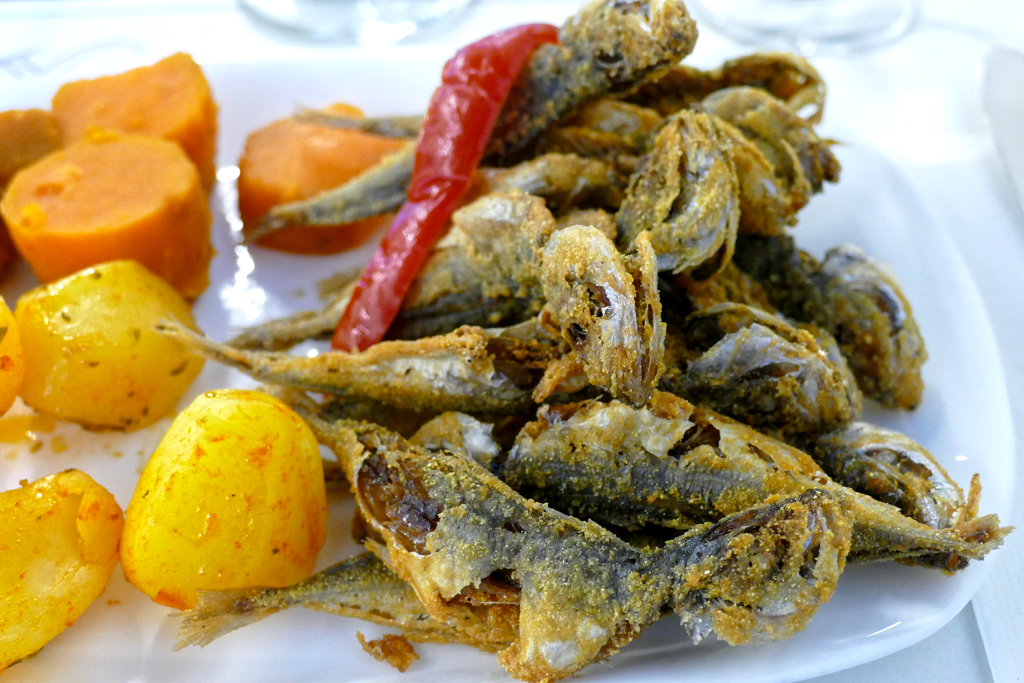
Inhames are local taro roots. They are commonly boiled and served with linguiça, a spicy Portuguese sausage. This combination is simple but filling, with the earthy taste of the taro complementing the spiced, smoky flavors of the sausage.
Just like the other islands of the central archipelago, Pico is known for its distinctive cheese, Queijo do Pico. It’s a semi-soft cheese made from cow’s milk with a slightly tangy flavor and a creamy texture.
Cash and Cards
Until now, 20 European countries replaced their former local currency with the €uro starting in 2002. Obviously, Portugal is one of them. The exchange rate is 1 US$ = 0.85 EUR as of September 2025. However, you can check today’s conversion rate on this page.
Paying with contactless or by credit card is very common everywhere.
Language
Language and communication in the Azores are deeply rooted in the region’s history, geography, and culture. The official language is Portuguese, obviously. Many of the settlers who colonized the islands in the 15th century were from regions of Portugal where older forms of Portuguese were spoken, so remnants can still be found in Azorean speech. However, the Azorean Portuguese dialect has its own distinct characteristics. As a matter of fact, each of the nine islands has variations in accent, vocabulary, and pronunciation, making Azorean Portuguese quite diverse. Despite these differences, speakers from the islands can generally understand each other, and the dialects are still considered part of the broader Portuguese language family.
The Azores have a significant history of emigration, particularly to the US, Canada, and Brazil. Therefore, in communities with strong ties to emigrant families, many Azoreans speak both Portuguese and English. In fact, English has become a secondary language in some areas due to the large Azorean diaspora in English-speaking countries. Also, due to international tourism, basically everyone working in that field speaks English more or less fluently.
Nevertheless, if you want to learn some basic Portuguese or just brush up on your knowledge, there are various apps and online tools. I personally like to practice with babbel.
Connection and Communication
Since June 2017, no roaming charges have applied within the EU with a European mobile phone contract. This applies to all 27 countries of the European Union as well as Iceland, Liechtenstein, and Norway. It pertains to all contracts.
When roaming is not available, you can connect to the internet at basically every museum, eatery, and, of course, hotel.
If you insist on being online 24/7, you can get a SIM card. For the best network coverage and balance of data options, MEO is considered the top choice for tourists visiting the Azores, especially for travelers heading to more remote islands. They offer prepaid SIM cards for tourists, MEO Go being the best option for tourists. You can get 15GB of data for 15 €uros, valid for 15 days. After that, you can top up, obviously.
MEO SIM cards can be purchased at Lisbon or Porto airports, in case you’re arriving in mainland Portugal first. Otherwise, you can get them at MEO stores across the Azores.
Other popular companies are Vodafone, NOS, and Lycamobile.
In Portugal, they use plug types C and F. Their voltage is 230 V and the frequency 50 Hz. Whereby, as nowadays all these chargers have integrated adapters, in general, the voltage and frequency don’t really matter.
By the way, you’ll find comprehensive travel info in my post World’s Most Complete Travel Information – an indispensable globetrotter classic.
Map
On this map, you can see where to find all the places I’m mentioning in this post. Clicking on the slider symbol at the top left or the full-screen icon at the top right will display the whole map.
Pico was only one of six islands that I visited during my amazing island hopping in the Azores. To read about the others, go to the main post and take your pick! There, you’ll also find further valuable general information that will make your own trip much smoother and more enjoyable.
Pinnable Pictures
If you choose to pin this post for later, please make sure to use one of these pictures:
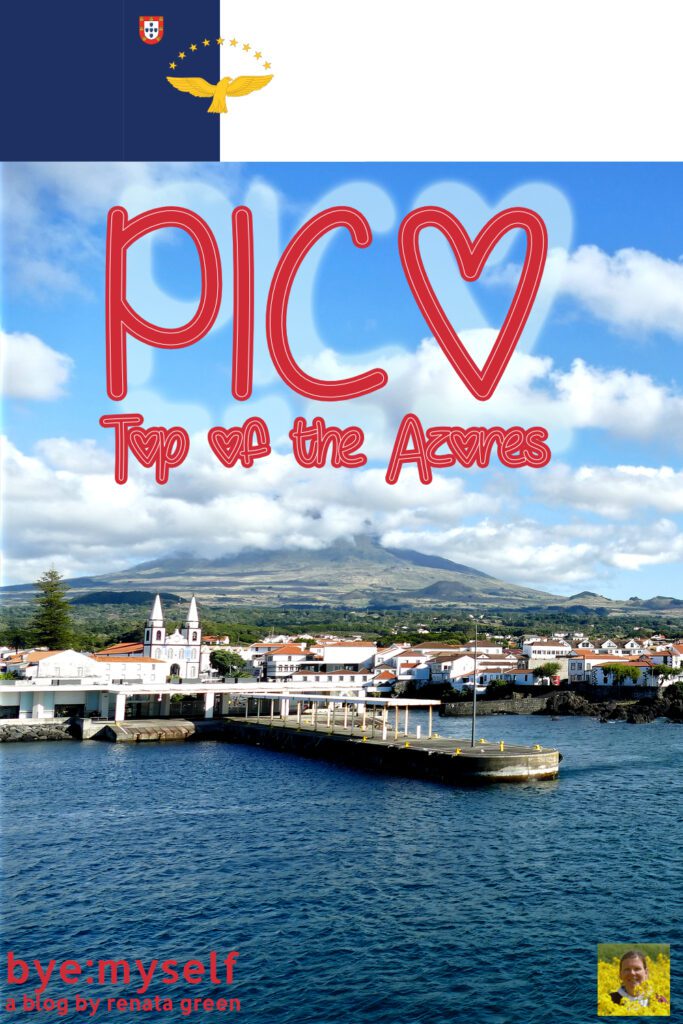


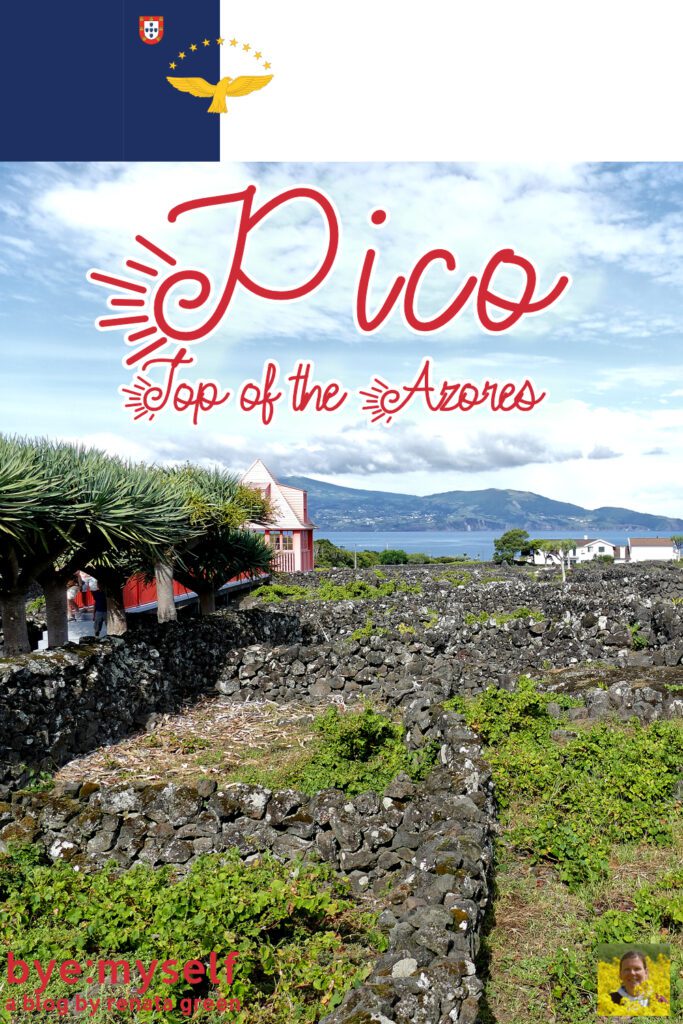


Note: I’m completing, editing, and updating this post regularly – last in September 2025.
Did You Enjoy This Post? Then You Might Also Like These:
Railroad Trip PORTUGAL
SAO JORGE – the Best Viewpoints of the Azores
Guide to COIMBRA. On the Beauty of Knowledge
Best Things to Do in SAO MIGUEL, the Most Varied Island of the Azores
Best Street Art in LISBON – Part III: Moscavide
Best Street Art in LISBON – Part II: Marvila
A Day in Sophisticated ESTORIL and CASCAIS
Best Street Art in PORTO
* This is an affiliate link. Hence, If you book through this page, not only do you get the best deal. I also get a small commission that helps me run this blog. Thank you so much for supporting me!
